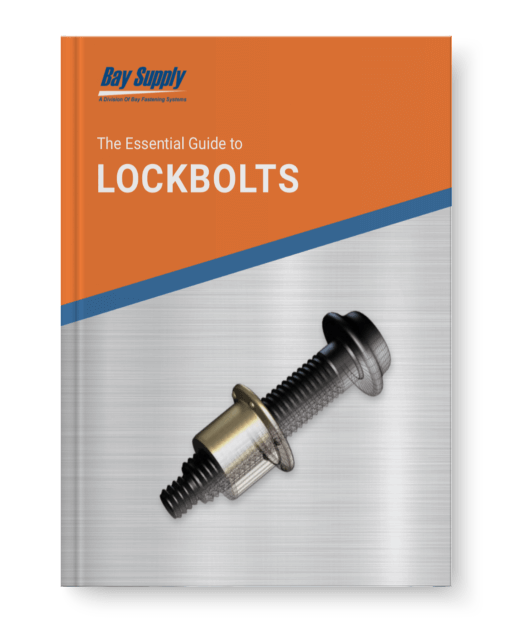First, the lockbolt pin is placed in a pre-drilled hole with the head on one side and the collar placed over the pin on the other side. The lockbolt tool is then placed over the fastener pintail. When activated, the lockbolt tool pulls the pin up, cinching the head on the far side and bringing the material together to form the initial joint. Installation is completed when the tool anvil presses the collar downward, applying pressure so the collar presses against the pin and swages the collar, forming a tight fit between the collar and the threads of the pin. When the tool releases the lockbolt, it breaks off the pintail (or releases the pin if the pintail is to remain intact), and installation is complete.
Every lockbolt is designed with a collar that is made of a softer material than the pin, so when the collar is swaged, it is tightly pressed into the grooves of the pin. The more metal-to-metal contact, the stronger the joint, and the less prone it will be to loosen with vibration.
There are a few important considerations to ensure that the lockbolt is properly installed and will provide a strong, lasting joint. The objective is to create a joint that has little or no movement to minimize metal fatigue. In fact, lockbolts tend to have shallower threads than conventional bolts, so there is more metal and a closer fit between the collar and the grooves to increase fatigue strength. The diameter of the hole also is a factor. The tighter the fit in the hole, the less movement in the joint, which increases joint strength and longevity.
You also want to match the power of the swaging tool to the lockbolt. Matching the torque of the tool to the tensile strength of the collar gives you an optimal connection. If the torque is too low, the connection may be loose; if the torque is too high, it could strip the lockbolt. You also want to be sure the swaging tool has little or no lateral motion.
To ensure you use the right tool for the lockbolt, it’s important to understand the various types of tools available.
Manual Lockbolt Installation Tools
For smaller lockbolts that carry less of a load, you often can use hand-operated lockbolt tools. There are a number of manual swaging tools that are typically used for simple jobs or for repairs.
One of the most popular manual lockbolt tools is the Marson® Big Daddy® Huck Tool. Designed specifically for 3/16- or 1/4-inch Huck Magna-Lok®, Magna-Tite®, and Magna-Grip fasteners, the Big Daddy has self-adjusting two-piece jaws to grasp the pin and extra-long handles to provide extra leverage. It’s ideal for truck and automotive bodies, floor structures, storage compartments, and other applications where hand-installed lockbolts are used.
Pneudraulic Lockbolt Installation Tools
For production volume lockbolt installations or larger bolts that need more powerful tools, pneudraulic tools are a good choice. Both Huck and Avdel have pneudraulic installation tools that are suitable for heavy- duty installations.
The Huck Model 2025 is designed for 3/16- and 1/4-inch diameter lockbolts and the Huck Model 256 will handle lockbolt diameters of 3/16-, 1/4-, 5/16-, and 3/8-inch. These tools are ergonomically designed for ongoing use with less operator fatigue and have separate vacuum pintail collection systems available. The 2025 is relatively lightweight at 5-7 pounds and delivers a pull capacity of 5,280 pounds at 90 psi of air. The Model 256 is more powerful, weighing in at 11 pounds and delivering 9,986 pounds of pull at 90 psi.
The Avdel ProSet® XT pneudraulic installation tool also is well-suited to production installation applications. The strongest tool of the ProSet series is the ProSet XT4, a lightweight yet study tool that delivers the highest pull force in the range. It is innovatively designed with a left or right and on/off swivel air fitting, which gives the operator additional flexibility while conserving energy.
The Avdel 73200-02000 is a hydro- pneumatic installation tool made for placing Avdel lockbolts up to 3/8 inches. It features a high pull force and long stroke, delivering 8,138 pounds at 80 psi and weighing 10 pounds for heavy-duty installations. It has an aerospace-grade aluminum alloy head and handle that make it lightweight yet durable. The 73200-02000 model is ergonomically designed to reduce shock loading during use and increase time before re-priming. Avdel offers a number of nose assemblies that can be used with this tool.
Hydraulic Lockbolt System Tools
For factory installations and applications where you need durable tools for ongoing use, both Huck and Avdel offer hydraulic system tools. These systems consist of interdependent parts, such as hoses, hydraulic pumps, and accessories that work together to deliver optimal lockbolt installation performance.
Huck Hydraulic Tools
For Huck lockbolts, Arconic offers a variety of hydraulic installation tools.
The SFBTT8 is the Swage Forward BobTail Tool, designed to install 1/4-inch, 5/16-inch, and 3/8-inch fasteners such as the BobTail. It is lighter and more compact than previous units, making it ideal for use in tight spaces. Similarly, the SF20 Swage Forward BobTail Tool works with 1/2-inch and 5/8-inch lockbolts with a 2-inch stroke; the SF32 works with 3/4-inch BobTails with a 2-inch stroke; and the SF46 works with 7/8-inch to 1-inch BobTails with a 2.5-inch stroke.
If you need a lightweight tool, the Huck 2480 weighs 2.21 pounds and offers high-speed installation of a variety of HuckBolts. The Model 2581 is a lightweight tool with a pull capacity of 10,700 pounds, and it has one moving part, which means more reliability and less maintenance. (Models 2582 and 2583 add an eccentric piston for better center-to-edge measurement, and the 2583 offers a longer stroke.)
For large-diameter HuckBolts, the Model 3585 is ideal for C50L and BobTails, and the 3585PT can be used for BobTail and HuckSpin lockbolts.
To round out its hydraulic lockbolt tool systems, Huck also offers various Powerig® hydraulic power sources and accessories.
The Model 940 Powerig is a portable hydraulic power unit with 120V or 220V AC electrical power designed for production and field use; it’s easy to transport with simple hydraulic outlets and couplers. The Model 913F Powerig is a portable gasoline-powered hydraulic power unit for use in the field where a power source is unavailable. It weighs 175 pounds when full of hydraulic fluid. The Model 918 and 918-5 are the largest hydraulic Powerigs available for high-production applications. The Model 918 can power two tools at a time and the 918-5 can power three hydraulic tools. These are electrical units that can generate enough pressure to power installation tools up to 100 feet away. Of course, Huck also offers a complete line of replacement hydraulic hoses, gauges, nose assemblies, and accessories to complete its hydraulic systems.
Avdel Hydraulic Tools
Avdel also offers a wide range of lockbolt tools, each with unique specifications for different lockbolts and applications.
The Avdel 7287 has a lightweight head to install NeoBolts (3/8 inches), Avdeloks (up to 3/8 inches), and other fasteners. It has a wide variety of interchangeable nose assemblies and can be fitted with a collar cropper to cut and remove lockbolts. It also has a remote intensifier which is mounted on casters to make it more portable.
Avdel’s 734 AVTM of tools can set all Avdelok and Avdelok XT lockbolts from 3/8 inches to 1-1/8 inches, as well as 1/2-inch to 1-inch NeoBolts and 5/16-inch to 5/8-inch Avbolts. These hydraulic tools are built to last with easy-to-change nose assemblies and hoses.
The AV series is powered by Avdel’s Enerpac® PRO Series pumps. These are high-efficiency pumps designed to run cooler with 18 percent less current, providing an outstanding power-to-
weight ratio and low-voltage operating characteristics. Of course, Avdel offers a variety of nose assemblies to accommodate different lockbolts, hoses, pressure setting gauges, and other accessories.
Huck Cordless Tools
Huck also introduced a line of cordless range-force lockbolt tools in partnership with Makita, a proven leader in industrial cordless tools. The Huck BV4500-118K2 is a robust tool that accepts the same nose assemblies used on the Huck 2025 pneudraulic tool. They have an electronically adjustable pull that pulls up to 4,500 pounds; the BV2200 model can pull up to 2,200 pounds. These tools are beneficial for their portability and versatility on the job.


 C6L
C6L C50L®
C50L®  Magna-Grip
Magna-Grip Avdelok
Avdelok Avdelok XT®
Avdelok XT®  Maxlok®
Maxlok®  BobTail
BobTail  HuckSpin 2
HuckSpin 2  NeoBolt®
NeoBolt® 